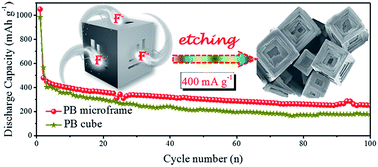A novel highly crystalline Fe4(Fe(CN)6)3 concave cube anode material for Li-ion batteries with high capacity and long life†
Abstract
Recently, Prussian blue and its analogues (PBs) have been widely investigated as cathode materials for sodium ion batteries (SIBs), but have rarely been reported as anode materials for lithium ion batteries (LIBs). Herein, we develop a novel and facile method to prepare highly crystalline and low-defect Prussian blue (PB) materials with a unique concave hierarchical structure, which significantly improves the stability of the materials and increases the active sites. The single crystal-like electron diffraction behavior observed in the SAED pattern and XPS data demonstrates their mesocrystalline nature and modified surface structure, respectively. More importantly, compared with iron ferricyanide previously reported, their discharge capacity has grown by 70% after the same number of cycles (100 cycles) at 1C, and the Li-storage performance is generally better than that of other PBs. As a novel material, the formation mechanism of the unique structure is investigated intensively and the effect of the structure on electrochemical performance is also explained.



 Please wait while we load your content...
Please wait while we load your content...